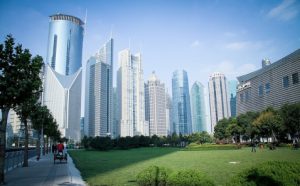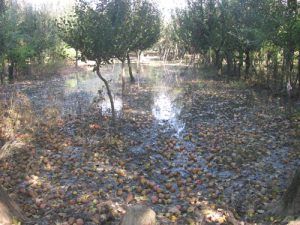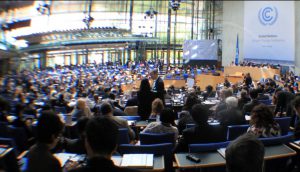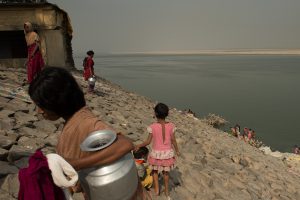“The tension between China’s rise as a global power and its contribution to catastrophic environmental change is coming to a furious head,” author Julie Sze points out in her thought-provoking new book, Fantasy Islands.
Sze is a native New Yorker, but her father hails from Chongming Island in the Yangtze delta, which used to be dismissed as a rural backwater offshore from Shanghai before it was set aside to create Dongtan, an eco-city for half a million people.
Now a professor of American Studies at the University of California, Davis, Sze’s book examines many aspects of the “failed promise of Dongtan” and other developments around Shanghai, China’s largest urban area.
Pitched as a showcase ultra-green city to be ready and functioning in time for the 2010 Shanghai World Expo, Dongtan was an ambitious joint project involving multinational engineering firm Arup and Chinese developers.
The scheme was conceived as a futuristic model for low-rise suburbs to accommodate spillover from supercities and house China’s emerging middle class.
The project touted ‘zero emissions’ as one of its main selling points, and recycled waste was included in the myriad renewable energy systems planned for Dongtan. The city would ban cars, recycle water and surround itself with organic farms, forests and golf courses.
The world’s longest bridge and tunnel now connects the wetlands building site and its looming wind turbines to Pudong, in outer Shanghai. Yet, five years after the World Expo the Dongtan dream has been abandoned.
The mega-project stalled in September 2006 after key officials were arrested for graft. Chen Liangyu, Shanghai’s top bureaucrat, was sentenced to 18 years in jail for bribery and fraudulent real estate transactions, while the former director general of the Shanghai Industrial Investment Corporation (SIIC), Wang Guoxiong, was given a life sentence for accepting bribes with his finance director Li Yizeng imprisoned for 15 years.
Most projects associated with the disgraced Chen have languished indefinitely, Sze points out, while permits for dozens of other major developments around China won approval. Many of the complications could have been avoided, Sze says. For example, Dongtang’s planners failed to comply with a government land use policy that required the local authority to reclaim an equal amount of property for any farmland used for development.
During this time, Chongming county officials were able to outpace the SIIC and proceeded to confiscate farmland, relocate peasants and invest in infrastructure.
“Green-building structures in Shanghai have become a symbol of technological and ecological sophistication in excess,” Sze adds, arguing that people’s behaviour and habits, such as family planning and diet, are just as vital as any cutting-edge engineering feats to sustain environmental improvements.
Sze’s scepticism about the wisdom of embracing an engineered “ecotopia”, and displacing entire populations in order to enable these large-scale fixes, underlines her analysis throughout this book.
“It is from my own fractured place of nostalgia, memory and diaspora that I examined this focus on the technological and the ecological in the most hyper-urban of cities,” Sze explains.
“I wrote this book as a grandchild of Shanghai and Chongming, living across the Pacific Rim. I’m writing as an Asian American suspicious of China-bashing as much as a committed environmentalist.” Sze is also the founding director of the Environmental Justice Project at UC Davis’ John Muir Institute for the Environment.
Sze, however, suggests corrupt officials aren’t the only ones to blame for Dongtan’s setbacks. Big international engineering firms, she writes, may have avoided taking responsibility for flaws in some large flagship projects because they did not acknowledge how “technology, engineering and politics were intimately woven together.”
She points out that ambitious plans are not necessarily doomed to fail, even in view of China’s “sea of complex internal local and regional politics, not always apparent to outsiders.” To succeed, Sze says, the role of individual citizens must also be factored into such plans, too. Autocratic political structures may be able impose radical change but not sustain it indefinitely.
Sze argues that an authoritarian top-down approach to eco-development will likely flounder if it fails to come to terms with a municipal order that on the surface appears chaotic. “Sustainability…takes power and people seriously, rather than as an afterthought to the techno-fetishism that eco-desire inhabits, glorifies, and draws its breath from,” Sze writes with characteristic fervour.
Sze also provides historical context for parts of Shanghai prior to the development push, reminding us that Chongming Island, now earmarked to double in population and serve as a major shipyard and manufacturing centre, was once known more for its brothels than the birds now found in its wetland.
Going back further, Japanese officers used the relatively remote area to test-run their notorious comfort stations, in which local women were enslaved as sex workers to service Emperor Hirohito’s soldiers during the Second World War. Decades on, Asia’s migratory fowl now stop over at estuaries that lap at the humble and haunted old villages of Chongming.
Non-academic readers may puzzle over her rather abstract terminology, which Sze tries to clarify: “Eco-desire is about representation trumping polluted reality. It’s not about valiant individuals fighting corporate polluters or economic investments in sustainability,” she stresses.
“Chinese eco-desire is based on three closely linked factors: technocratic faith in engineering, reliance on authoritarian political structures to facilitate environmental improvements, and discourse of ‘ecological harmony’ between man and nature”.
The scale of Chinese eco-technological projects, meanwhile, still dwarfs most of their counterparts in Europe and North America, and in the age of climate crisis, western partners now compete to help modernise China’s megacities at the same time they try to counteract environmental degradation. Sze calls for more effective strategies and interventions, but she leaves these details up to the technicians.
Fantasy Islands: Chinese Dreams and Ecological Fears in an Age of Climate Crisis, by Julie Sze, University of California Press







